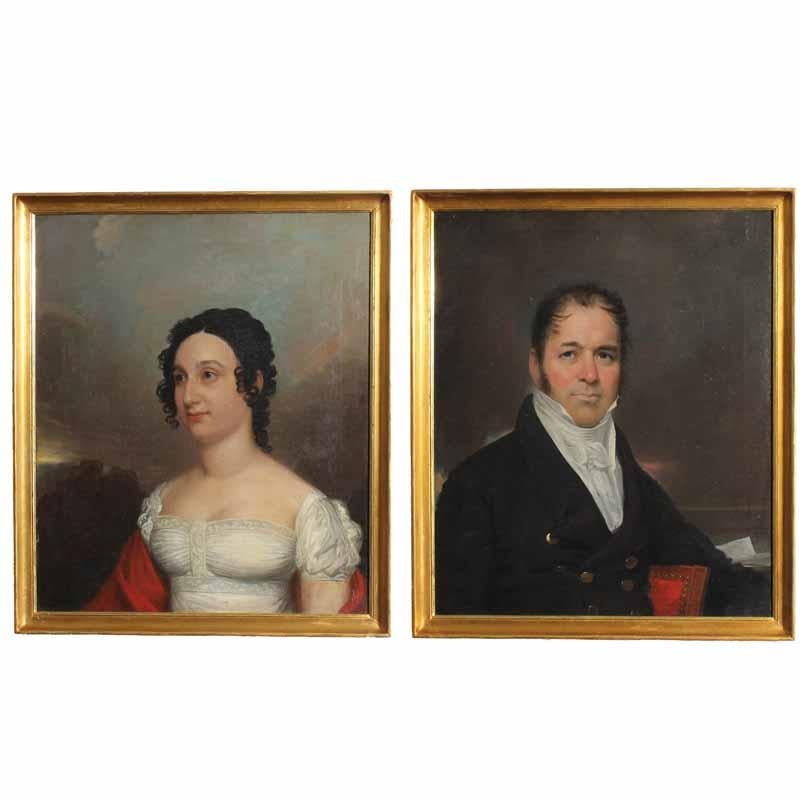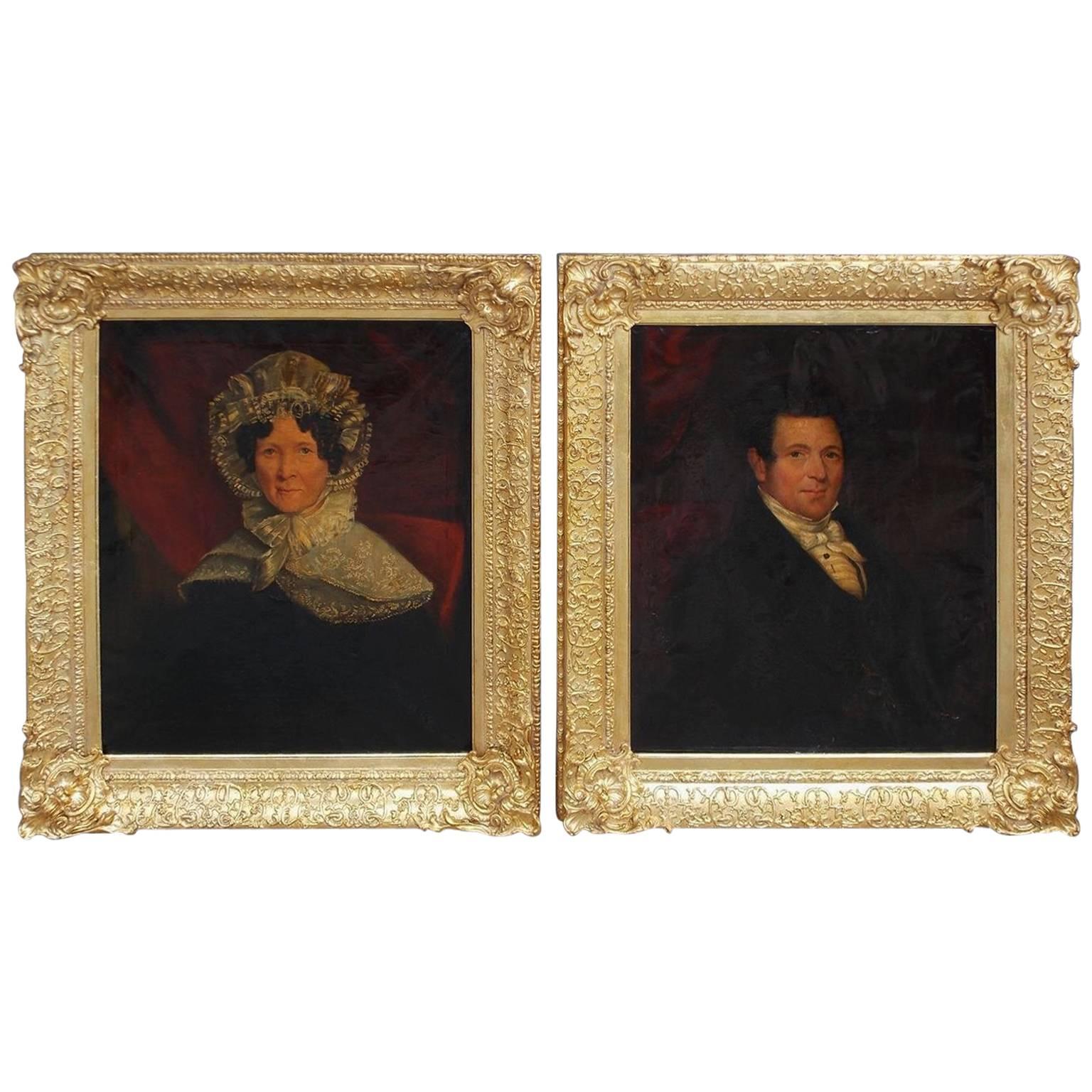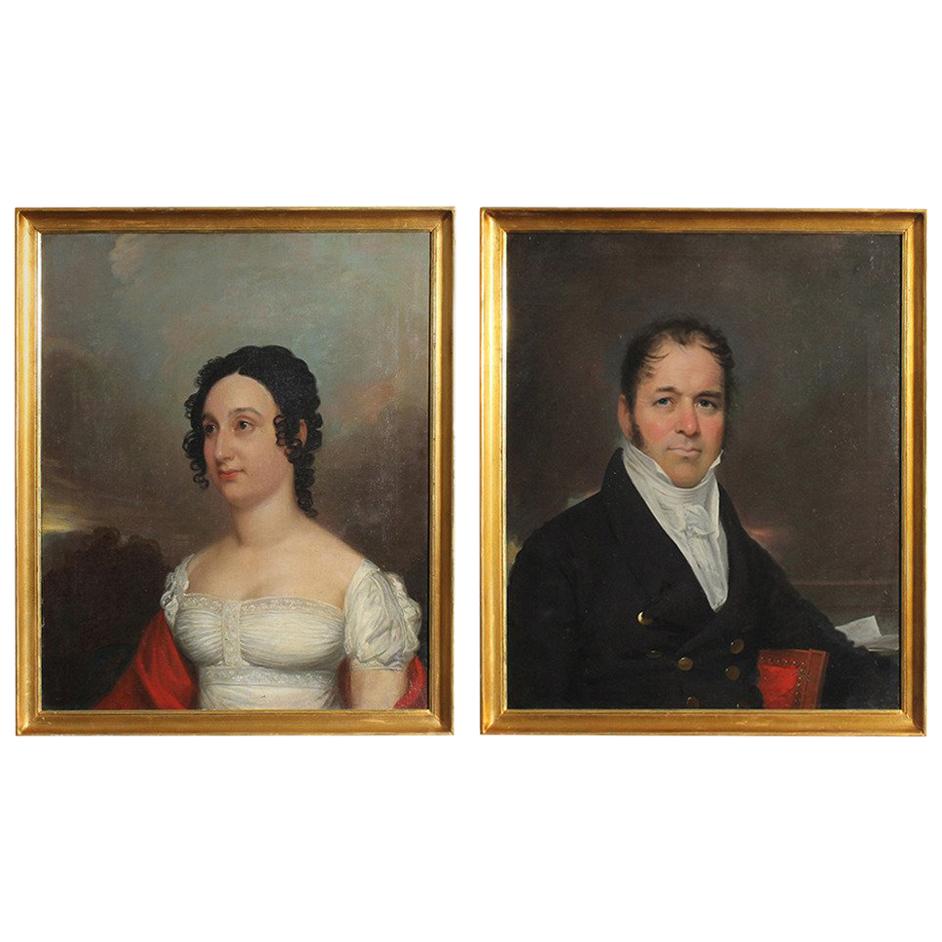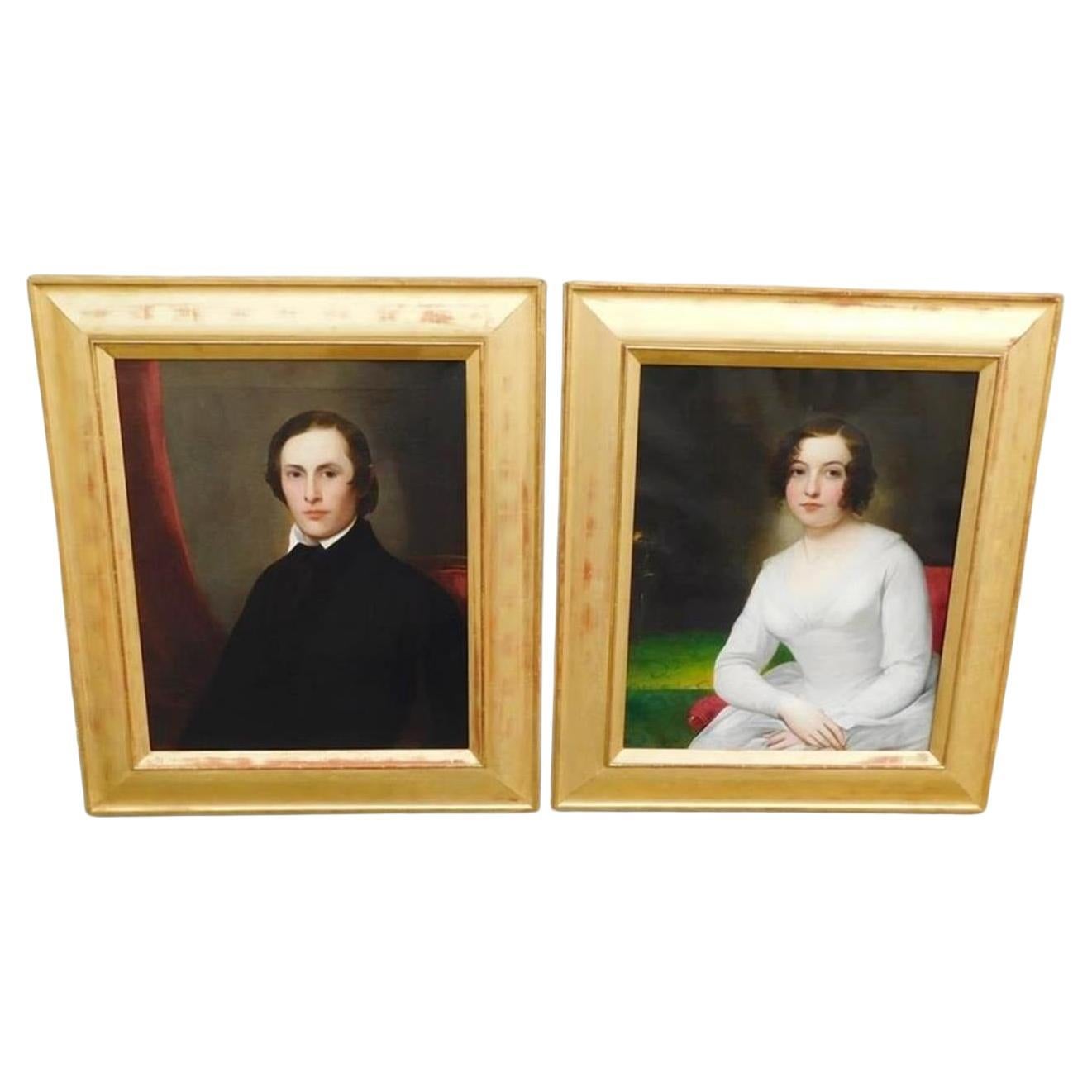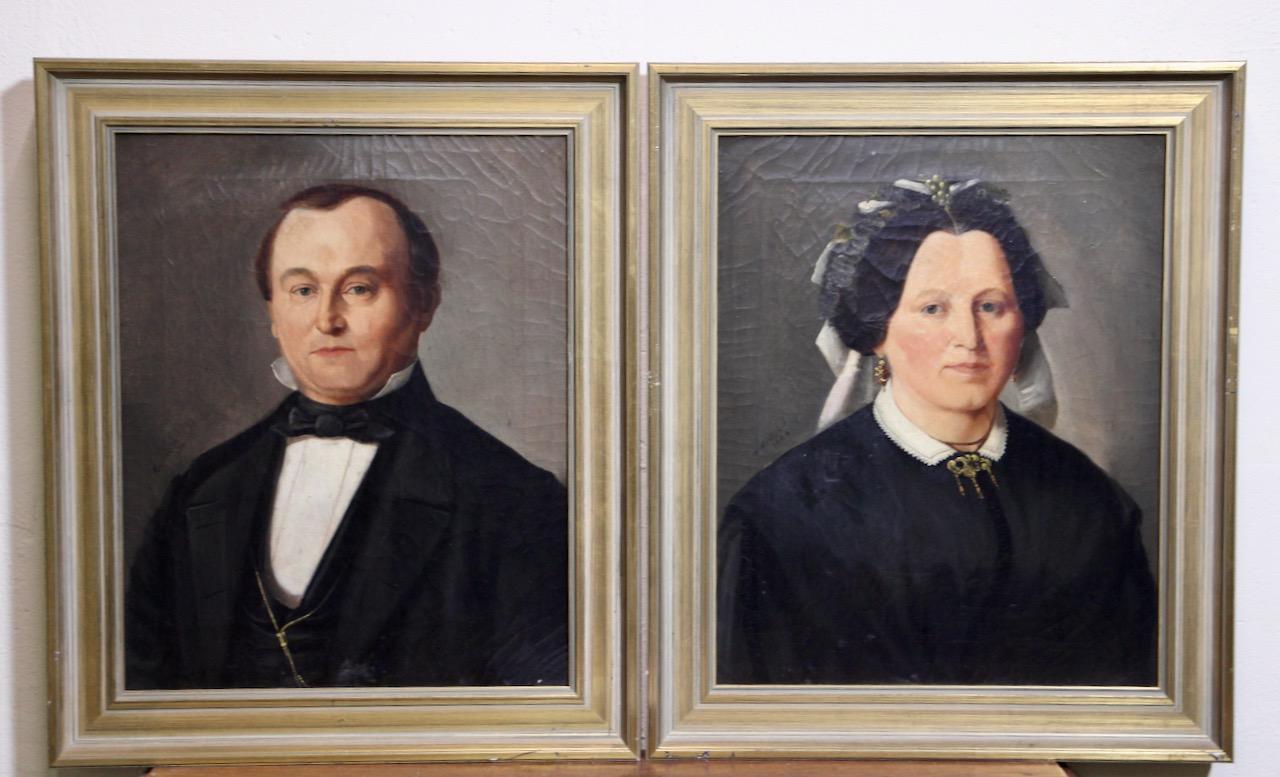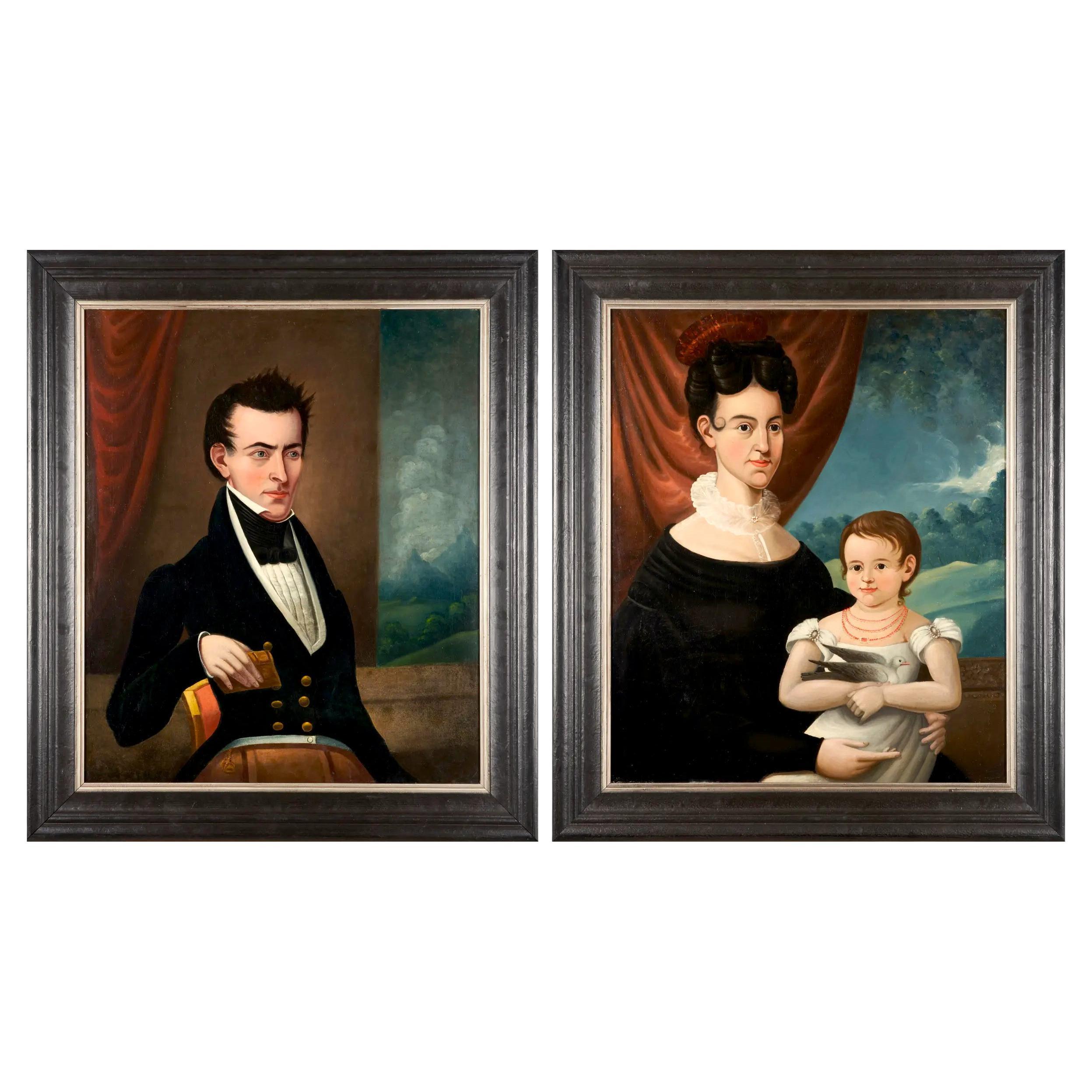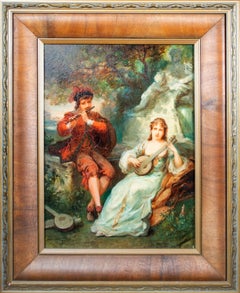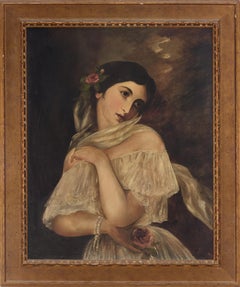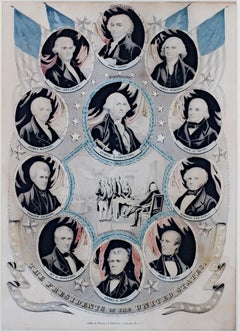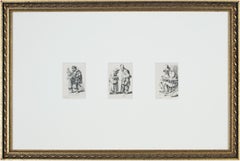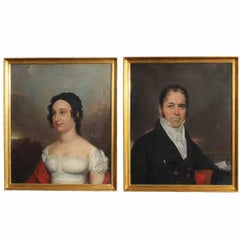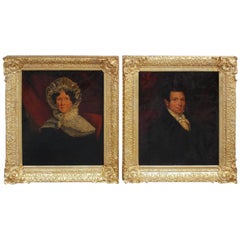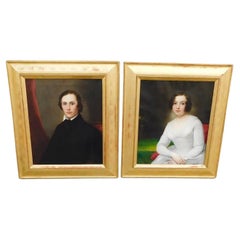Items Similar to 18th century diptych portraits man and woman American formal dress flower
Want more images or videos?
Request additional images or videos from the seller
1 of 12
William Jennys18th century diptych portraits man and woman American formal dress flowercirca 1799
circa 1799
$169,000
£127,539.65
€146,013.62
CA$238,346.03
A$261,674.22
CHF 136,516
MX$3,166,622.32
NOK 1,711,016.13
SEK 1,612,227.05
DKK 1,089,952.71
About the Item
The present pair of portraits would make an exceptional addition to any collection of early American art not only because they were painted by the notable William Jennys, but also because the sitters are members of notable and influential New England families. In addition, these pendants have impeccable provenance: they have never left ownership of the decedents of the Kimball family and this is the first time they have been available for purchase.
David Kimball (1766-1848) and Nancy Stacy Kimball (1774-1844) were members of historic Massachusetts families. David Kimball is a sixth-generation decedent of Richard Kimball (d. 1675) and Ursula Scott (d. 1659), who emigrated from Rattlasden, Suffolk County, England to Watertown MA around 1634. The family then relocated in 1637 to Ipswich, the city with which the family is now most strongly identified, when Richard was appointed to be a wheelwright.[1] Nancy likewise had early New England ancestry, descended from Simon Stacy and Elizabeth Clark, who were married in London in 1620.[2]
Nancy Stacy was the second wife of David Kimball, and the two were married in 1799. Given this, the present pendant portraits were likely completed shortly after the marriage. David had two children by his first wife Mary Morse, who died in September of 1798. David and Nancy would have nine additional children between 1801 and 1815.[3]
Most notably, the couple were parents of the Boston politician and showman Moses Kimball (1809-1895).[2][3] Moses would found the Boston Museum, an early for-profit museum and theater opened in 1841 that resembled European curiosity cabinets: the museum displayed paintings of Thomas Scully and Charles Peale alongside Chinese artwork, stuffed animals, dwarves and mermaids. Alongside these exhibits, visitors could attend the theater which held performances by gymnasts and contortionists, followed by performances of Shakespeare and Dickens.[4] This museum set the model for the Museum of Fine Arts, Boston, which when founded in 1870 held a similarly diverse collection and appealed to the interests of a diverse set of visitors.[5] Moreover, some Greek antiquities from Moses Kimball's museum were eventually given to the MFA and Moses donated approximately $5,000 to the MFA's endowment upon his death.[6][7]
William Jennys (1774–1859), also known as J. William Jennys, is an important American primitive portrait painter who was active from about 1790 to 1810. He traveled throughout New England seeking commissions in rural areas and small towns.[8] Although the Inventory of American Painting lists more than one hundred works by William Jennys and an additional eighty ascribed to him, there is surprisingly little known about this prolific artist's life. He may have been the son, or perhaps the younger brother, of the portraitist Richard Jennys (active 1766-1801). Both artists worked in New Milford, Connecticut, beginning about 1795 and William's earliest known paintings were produced there. An advertisement which he placed in the Norwich (Connecticut) Packet in 1793, however, indicates that by then he was a practicing professional.[9]
In 1797 and 1798 Jennys worked in New York City. After 1800 he traveled through New England, moving up the Connecticut River Valley to paint in Hatfield and Deerfield, Massachusetts, around 1801 and thereafter visiting Portsmouth, New Hampshire, Newburyport, Massachusetts, and several towns in Vermont. He produced primarily waist-length portraits, and was known active through 1807.[9]
Paintings by Jennys can be found on view in several important collections of American art, including the Metropolitan Museum of Art, the Honolulu Museum of Art, Connecticut Historical Society, the Minneapolis Institute of Arts, the Museum of Fine Arts, Boston, the National Gallery of Art in Washington D.C., the Rockefeller Folk Art Collection, and the Utah Museum of Fine Arts.[8]
These paintings are framed to museum standards in modern 22K gold leaf American Colonial style custom mouldings.
29 1/8 x 22 1/8 inches, each canvas
34 x 27 inches, each frame
[1] Morrison, Leonard Allison and Stephen Paschall Sharples. History of the Kimball Family in America, from 1634 to 1897, Volume 1. Boston, MA: Damrell & Upham, 1897, pp. 27-28.
[2] Cummings, Charles. Memoir of Moses Kimball. Boston, MA: Press of David Clapp & Son, 1902, p. 3.
[3] Morrison and Sharples, History of the Kimball Family, 363.
[4] Levitt, Peggy. Artifacts and Allegiances: How Museums Put the Nation and the World on Display. Oakland, CA: University of California Press, 2015, p. 170.
[5] Belk, Russel. Collecting in a Consumer Society. New York: Routledge, 2013, No pagination.
[6] Friedland, Sobocinski and Gazda. The Oxford Handbook of Roman Sculpture. New York: Oxford University Press, 2013, p. 48.
[7] Museum of Fine Arts, Boston Twenty-Eighth Annual Report for the year 1903. Cambridge, MA: The University Press, 1904, p. 16.
[8] Wikipedia, The Free Encyclopedia, s.v. "William Jennys," (accessed 22 February 2020)
[9] "William Jennys," National Gallery of Art, Washington D.C. (accessed 22 February 2020)
- Creator:William Jennys (1774 - 1859, American)
- Creation Year:circa 1799
- Dimensions:Height: 34 in (86.36 cm)Width: 54 in (137.16 cm)
- Medium:
- Movement & Style:
- Period:1790-1799
- Condition:These paintings underwent conservation treatment in 2015. Feel free to contact the gallery for additional condition information.
- Gallery Location:Milwaukee, WI
- Reference Number:Seller: 12189c and 12190c1stDibs: LU60532417703
About the Seller
4.9
Platinum Seller
Premium sellers with a 4.7+ rating and 24-hour response times
Established in 1966
1stDibs seller since 2017
447 sales on 1stDibs
Typical response time: 3 hours
- ShippingRetrieving quote...Shipping from: Milwaukee, WI
- Return Policy
Authenticity Guarantee
In the unlikely event there’s an issue with an item’s authenticity, contact us within 1 year for a full refund. DetailsMoney-Back Guarantee
If your item is not as described, is damaged in transit, or does not arrive, contact us within 7 days for a full refund. Details24-Hour Cancellation
You have a 24-hour grace period in which to reconsider your purchase, with no questions asked.Vetted Professional Sellers
Our world-class sellers must adhere to strict standards for service and quality, maintaining the integrity of our listings.Price-Match Guarantee
If you find that a seller listed the same item for a lower price elsewhere, we’ll match it.Trusted Global Delivery
Our best-in-class carrier network provides specialized shipping options worldwide, including custom delivery.More From This Seller
View All19th century realist oil painting figurative man and woman outdoors garden
Located in Milwaukee, WI
Émile Bemindt was a French artist active between 1859 and 1872 and is best known for work in the style of the Rococo Revival: During the late nineteenth ...
Category
Late 19th Century Rococo Figurative Paintings
Materials
Oil, Board
Female Oil Portrait Delicate Austria Romantic 1800s Vintage Woman Realism Signed
Located in Milwaukee, WI
Art: 30" x 24"
Frame: 36.50" x 30.50"
Oil on canvas signed and dated lower right.
Category
1880s Romantic Portrait Paintings
Materials
Oil, Canvas
19th century color lithograph portraits patriotic American stars flags
By Nathaniel Currier
Located in Milwaukee, WI
"The Presidents of the U.S." is an original hand-colored lithograph by Nathaniel Currier. It features the first eleven presidents of the United States.
14" x 10" art
23" x 19 1/8" frame
Nathaniel Currier was born March 27, 1813 to Nathaniel and Hannah Currier in Roxbury, Massachusetts. At the age of fifteen he was apprenticed to William S. and John Pendleton of Boston who had set up the first lithographic establishment in America. His apprenticeship served him well as he went on to be the largest publisher of lithographs. Mr. Maurer described Nat Currier as being very gentlemanly and liberal. As is evident to the success of the firm of Currier & Ives he was very devoted to his business.
Nat Currier had many friends including Horace Greely and P.T. Barnum. He was well known for his sense of humor and Harry T. Peters tells one story about P. T. Barnum. "Currier had heard that one day his friend, the great showman, had rushed into the barber shop of the old Park Hotel, at Beekman and Nassau Streets, to get a shave. Barnum had hurried up to Tom Higginson, the barber, and said, 'Tom, I'm in a hurry.' 'Sorry for it,' said Tom, 'but it's that gentleman's turn next.' 'That gentleman' was an unshaven irshman waiting for a ten-cent shave. Barnum turned to him and said, 'My friend, if you will let me have your turn, I'll pay for what you have done.' The gentleman consented, and, as Barnum found out later, had a full job done - absolutely everything the house had. The check was for a dollar and sixty cents. When Currier heard this story he found the very Irishman and had him pose. The result was the famous cartoon, "The Man that Gave Barnum 'His Turn.'"
Nathaniel was married twice; his first wife was Miss Eliza West of Boston. He had one son with Eliza, Edward West Currier. In 1847 he married Miss Laura Ormsbee of Vermont. Laura and Nathaniel are memorialized in the famous N. Currier lithograph The Road Winter...
Category
1840s Academic Portrait Prints
Materials
Lithograph
18th century triptych etching figurative prints small black and white expressive
By Francois Vivares
Located in Milwaukee, WI
François Vivares was known to have produced several copies of images after older masters, such as, in this case, Rembrandt van Rijn. In this set, Vivares reproduces "The Quacksalver" (1635, Bartsch 129), "Beggar man and beggar woman conversing" (1630, Bartsch 164), and "Beggar Seated Warming...
Category
1760s Old Masters Figurative Prints
Materials
Etching
19th century color lithograph still life vase flowers
By Nathaniel Currier
Located in Milwaukee, WI
The present hand-colored lithograph is one of several decorative images of flower-filled vases published by Nathaniel Currier. This example contains roses, tulips, forget-me-nots, and others all within a vase with gold eagle head handles and an image of a beautiful young woman the belly.
16 x 11 inches, artwork
22.5 x 18.25 inches, frame
Entitled bottom center
Signed in the stone, lower left "Lith. and Pub. by N. Currier"
Inscribed lower right "152 Nassau St. Cor. of Spruce N.Y."
Copyrighted bottom center "Entered according to Act of Congress in the year 1848 by N. Currier in the Clerk's office of the Southern District of N.Y." with the number 249
Framed to conservation standards using 100 percent rag matting, housed in a lemon gold moulding.
Nathaniel Currier was a tall introspective man with a melancholy nature. He could captivate people with his piercing stare or charm them with his sparkling blue eyes. Nathaniel was born in Roxbury, Massachusetts on March 27th, 1813, the second of four children. His parents, Nathaniel and Hannah Currier, were distant cousins who lived a humble yet spartan life. When Nathaniel was eight years old, tragedy struck. Nathaniel’s father unexpectedly passed away leaving Nathaniel and his eleven-year-old brother Lorenzo to provide for the family. In addition to their mother, Nathaniel and Lorenzo had to care for six-year-old sister Elizabeth and two-year-old brother Charles. Nathaniel worked a series of odd jobs to support the family, and at fifteen, he started what would become a life-long career when he apprenticed in the Boston lithography shop of William and John Pendleton.
A Bavarian gentleman named Alois Senefelder invented lithography just 30 years prior to young Nat Currier’s apprenticeship. While under the employ of the brothers Pendleton, Nat was taught the art of lithography by the firm’s chief printer, a French national named Dubois, who brought the lithography trade to America.
Lithography involves grinding a piece of limestone flat and smooth then drawing in mirror image on the stone with a special grease pencil. After the image is completed, the stone is etched with a solution of aqua fortis leaving the greased areas in slight relief. Water is then used to wet the stone and greased-ink is rolled onto the raised areas. Since grease and water do not mix, the greased-ink is repelled by the moisture on the stone and clings to the original grease pencil lines. The stone is then placed in a press and used as a printing block to impart black on white images to paper.
In 1833, now twenty-years old and an accomplished lithographer, Nat Currier left Boston and moved to Philadelphia to do contract work for M.E.D. Brown, a noted engraver and printer. With the promise of good money, Currier hired on to help Brown prepare lithographic stones of scientific images for the American Journal of Sciences and Arts. When Nat completed the contract work in 1834, he traveled to New York City to work once again for his mentor John Pendleton, who was now operating his own shop located at 137 Broadway. Soon after the reunion, Pendleton expressed an interest in returning to Boston and offered to sell his print shop to Currier. Young Nat did not have the financial resources to buy the shop, but being the resourceful type he found another local printer by the name of Stodart. Together they bought Pendleton’s business.
The firm ‘Currier & Stodart’ specialized in "job" printing. They produced many different types of printed items, most notably music manuscripts for local publishers. By 1835, Stodart was frustrated that the business was not making enough money and he ended the partnership, taking his investment with him. With little more than some lithographic stones, and a talent for his trade, twenty-two year old Nat Currier set up shop in a temporary office at 1 Wall Street in New York City. He named his new enterprise ‘N. Currier, Lithographer’
Nathaniel continued as a job printer and duplicated everything from music sheets to architectural plans. He experimented with portraits, disaster scenes and memorial prints, and any thing that he could sell to the public from tables in front of his shop. During 1835 he produced a disaster print Ruins of the Planter's Hotel, New Orleans, which fell at two O’clock on the Morning of the 15th of May 1835, burying 50 persons, 40 of whom Escaped with their Lives. The public had a thirst for newsworthy events, and newspapers of the day did not include pictures. By producing this print, Nat gave the public a new way to “see” the news. The print sold reasonably well, an important fact that was not lost on Currier.
Nat met and married Eliza Farnsworth in 1840. He also produced a print that same year titled Awful Conflagration of the Steamboat Lexington in Long Island Sound on Monday Evening, January 18, 1840, by which melancholy occurrence over One Hundred Persons Perished. This print sold out very quickly, and Currier was approached by an enterprising publication who contracted him to print a single sheet addition of their paper, the New York Sun. This single page paper is presumed to be the first illustrated newspaper ever published.
The success of the Lexington print launched his career nationally and put him in a position to finally lift his family up. In 1841, Nat and Eliza had their first child, a son they named Edward West Currier. That same year Nat hired his twenty-one year old brother Charles and taught him the lithography trade, he also hired his artistically inclined brother Lorenzo to travel out west and make sketches of the new frontier as material for future prints. Charles worked for the firm on and off over the years, and invented a new type of lithographic crayon which he patented and named the Crayola. Lorenzo continued selling sketches to Nat for the next few years.
In 1843, Nat and Eliza had a daughter, Eliza West Currier, but tragedy struck in early 1847 when their young daughter died from a prolonged illness. Nat and Eliza were grief stricken, and Eliza, driven by despair, gave up on life and passed away just four months after her daughter’s death.
The subject of Nat Currier’s artwork changed following the death of his wife and daughter, and he produced many memorial prints and sentimental prints during the late 1840s. The memorial prints generally depicted grief stricken families posed by gravestones (the stones were left blank so the purchasers could fill in the names of the dearly departed). The sentimental prints usually depicted idealized portraits of women and children, titled with popular Christian names of the day.
Late in 1847, Nat Currier married Lura Ormsbee, a friend of the family. Lura was a self-sufficient woman, and she immediately set out to help Nat raise six-year-old Edward and get their house in order. In 1849, Lura delivered a son, Walter Black Currier, but fate dealt them a blow when young Walter died one year later. While Nat and Lura were grieving the loss of their new son, word came from San Francisco that Nat’s brother Lorenzo had also passed away from a brief illness. Nat sank deeper into his natural quiet melancholy. Friends stopped by to console the couple, and Lura began to set an extra place at their table for these unexpected guests. She continued this tradition throughout their lives.
In 1852, Charles introduced a friend, James Merritt Ives, to Nat and suggested he hire him as a bookkeeper. Jim Ives was a native New Yorker born in 1824 and raised on the grounds of Bellevue Hospital where his father was employed as superintendent. Jim was a self-trained artist and professional bookkeeper. He was also a plump and jovial man, presenting the exact opposite image of his new boss.
Jim Ives met Charles Currier through Caroline Clark, the object of Jim’s affection. Caroline’s sister Elizabeth was married to Charles, and Caroline was a close friend of the Currier family. Jim eventually proposed marriage to Caroline and solicited an introduction to Nat Currier, through Charles, in hopes of securing a more stable income to support his future wife.
Ives quickly set out to improve and modernize his new employer’s bookkeeping methods. He reorganized the firm’s sizable inventory, and used his artistic skills to streamline the firm’s production methods. By 1857, Nathaniel had become so dependent on Jims’ skills and initiative that he offered him a full partnership in the firm and appointed him general manager. The two men chose the name ‘Currier & Ives’ for the new partnership, and became close friends.
Currier & Ives produced their prints in a building at 33 Spruce Street where they occupied the third, fourth and fifth floors. The third floor was devoted to the hand operated printing presses that were built by Nat's cousin, Cyrus Currier, at his shop Cyrus Currier & Sons in Newark, NJ. The fourth floor found the artists, lithographers and the stone grinders at work. The fifth floor housed the coloring department, and was one of the earliest production lines in the country. The colorists were generally immigrant girls, mostly German, who came to America with some formal artistic training. Each colorist was responsible for adding a single color to a print. As a colorist finished applying their color, the print was passed down the line to the next colorist to add their color. The colorists worked from a master print displayed above their table, which showed where the proper colors were to be placed. At the end of the table was a touch up artist who checked the prints for quality, touching-in areas that may have been missed as it passed down the line. During the Civil War, demand for prints became so great that coloring stencils were developed to speed up production.
Although most Currier & Ives prints were colored in house, some were sent out to contract artists. The rate Currier & Ives paid these artists for coloring work was one dollar per one hundred small folios (a penny a print) and one dollar per one dozen large folios. Currier & Ives also offered uncolored prints to dealers, with instructions (included on the price list) on how to 'prepare the prints for coloring.' In addition, schools could order uncolored prints from the firm’s catalogue to use in their painting classes.
Nathaniel Currier and James Merritt Ives attracted a wide circle of friends during their years in business. Some of their more famous acquaintances included Horace Greeley, Phineas T. Barnum, and the outspoken abolitionists Rev. Henry Ward, and John Greenleaf Whittier (the latter being a cousin of Mr. Currier).
Nat Currier and Jim Ives described their business as "Publishers of Cheap and Popular Pictures" and produced many categories of prints. These included Disaster Scenes, Sentimental Images, Sports, Humor, Hunting Scenes, Politics, Religion, City and Rural Scenes, Trains, Ships, Fire Fighters, Famous Race Horses, Historical Portraits, and just about any other topic that satisfied the general public's taste. In all, the firm produced in excess of 7500 different titles, totaling over one million prints produced from 1835 to 1907.
Nat Currier retired in 1880, and signed over his share of the firm to his son Edward. Nat died eight years later at his summer home 'Lion’s Gate' in Amesbury, Massachusetts. Jim Ives remained active in the firm until his death in 1895, when his share of the firm passed to his eldest son, Chauncey.
In 1902, faced will failing health from the ravages of Tuberculosis, Edward Currier sold his share of the firm to Chauncey Ives...
Category
1840s Romantic Still-life Prints
Materials
Watercolor, Lithograph
19th century color lithograph portraits ship seascape patriotic flags military
By Nathaniel Currier
Located in Milwaukee, WI
The present hand-colored lithograph is an excellent example of patriotic mid-nineteenth century American imagery. The print shows the battle and several of the major figures involved in the Battle of Lake Erie: At the center is a view of several frigates on the lake, embroiled in conflict. Above the battle is the quotation: "We have met the enemy and they are ours." Surrounding are laurel-lined roundels with portraits of Oliver Hazard Perry (1785-1819), Stephen Dicateur (1779-1820), Johnston Blakeley (1871-1814), William Bainbridge (1774-1833), David Porter (1780-1843), and James Lawrence (1781-1813) - all of these framed by American flags, banners and cannons. This print shows that the Battle of Lake Erie, part of the War of 1812, still held resonance for American audiences several decades later and was part of the larger narrative of the founding of the country.
9.5 x 13.5 inches, artwork
20 x 23.38 inches, frame
Entitled in the image
Signed in the stone, lower left "Lith. and Pub. by N. Currier"
Inscribed lower right "2 Spruce N.Y." and "No. 1"
Copyrighted lower center "Entered according to Act of Congress in the year 1846 by N. Currier in the Clerk's office of the Southern District of N.Y."
Framed to conservation standards using 100 percent rag matting and housed in a gold gilded moulding.
Nathaniel Currier was a tall introspective man with a melancholy nature. He could captivate people with his piercing stare or charm them with his sparkling blue eyes. Nathaniel was born in Roxbury, Massachusetts on March 27th, 1813, the second of four children. His parents, Nathaniel and Hannah Currier, were distant cousins who lived a humble yet spartan life. When Nathaniel was eight years old, tragedy struck. Nathaniel’s father unexpectedly passed away leaving Nathaniel and his eleven-year-old brother Lorenzo to provide for the family. In addition to their mother, Nathaniel and Lorenzo had to care for six-year-old sister Elizabeth and two-year-old brother Charles. Nathaniel worked a series of odd jobs to support the family, and at fifteen, he started what would become a life-long career when he apprenticed in the Boston lithography shop of William and John Pendleton.
A Bavarian gentleman named Alois Senefelder invented lithography just 30 years prior to young Nat Currier’s apprenticeship. While under the employ of the brothers Pendleton, Nat was taught the art of lithography by the firm’s chief printer, a French national named Dubois, who brought the lithography trade to America.
Lithography involves grinding a piece of limestone flat and smooth then drawing in mirror image on the stone with a special grease pencil. After the image is completed, the stone is etched with a solution of aqua fortis leaving the greased areas in slight relief. Water is then used to wet the stone and greased-ink is rolled onto the raised areas. Since grease and water do not mix, the greased-ink is repelled by the moisture on the stone and clings to the original grease pencil lines. The stone is then placed in a press and used as a printing block to impart black on white images to paper.
In 1833, now twenty-years old and an accomplished lithographer, Nat Currier left Boston and moved to Philadelphia to do contract work for M.E.D. Brown, a noted engraver and printer. With the promise of good money, Currier hired on to help Brown prepare lithographic stones of scientific images for the American Journal of Sciences and Arts. When Nat completed the contract work in 1834, he traveled to New York City to work once again for his mentor John Pendleton, who was now operating his own shop located at 137 Broadway. Soon after the reunion, Pendleton expressed an interest in returning to Boston and offered to sell his print shop to Currier. Young Nat did not have the financial resources to buy the shop, but being the resourceful type he found another local printer by the name of Stodart. Together they bought Pendleton’s business.
The firm ‘Currier & Stodart’ specialized in "job" printing. They produced many different types of printed items, most notably music manuscripts for local publishers. By 1835, Stodart was frustrated that the business was not making enough money and he ended the partnership, taking his investment with him. With little more than some lithographic stones, and a talent for his trade, twenty-two year old Nat Currier set up shop in a temporary office at 1 Wall Street in New York City. He named his new enterprise ‘N. Currier, Lithographer’
Nathaniel continued as a job printer and duplicated everything from music sheets to architectural plans. He experimented with portraits, disaster scenes and memorial prints, and any thing that he could sell to the public from tables in front of his shop. During 1835 he produced a disaster print Ruins of the Planter's Hotel, New Orleans, which fell at two O’clock on the Morning of the 15th of May 1835, burying 50 persons, 40 of whom Escaped with their Lives. The public had a thirst for newsworthy events, and newspapers of the day did not include pictures. By producing this print, Nat gave the public a new way to “see” the news. The print sold reasonably well, an important fact that was not lost on Currier.
Nat met and married Eliza Farnsworth in 1840. He also produced a print that same year titled Awful Conflagration of the Steamboat Lexington in Long Island Sound on Monday Evening, January 18, 1840, by which melancholy occurrence over One Hundred Persons Perished. This print sold out very quickly, and Currier was approached by an enterprising publication who contracted him to print a single sheet addition of their paper, the New York Sun. This single page paper is presumed to be the first illustrated newspaper ever published.
The success of the Lexington print launched his career nationally and put him in a position to finally lift his family up. In 1841, Nat and Eliza had their first child, a son they named Edward West Currier. That same year Nat hired his twenty-one year old brother Charles and taught him the lithography trade, he also hired his artistically inclined brother Lorenzo to travel out west and make sketches of the new frontier as material for future prints. Charles worked for the firm on and off over the years, and invented a new type of lithographic crayon which he patented and named the Crayola. Lorenzo continued selling sketches to Nat for the next few years.
In 1843, Nat and Eliza had a daughter, Eliza West Currier, but tragedy struck in early 1847 when their young daughter died from a prolonged illness. Nat and Eliza were grief stricken, and Eliza, driven by despair, gave up on life and passed away just four months after her daughter’s death.
The subject of Nat Currier’s artwork changed following the death of his wife and daughter, and he produced many memorial prints and sentimental prints during the late 1840s. The memorial prints generally depicted grief stricken families posed by gravestones (the stones were left blank so the purchasers could fill in the names of the dearly departed). The sentimental prints usually depicted idealized portraits of women and children, titled with popular Christian names of the day.
Late in 1847, Nat Currier married Lura Ormsbee, a friend of the family. Lura was a self-sufficient woman, and she immediately set out to help Nat raise six-year-old Edward and get their house in order. In 1849, Lura delivered a son, Walter Black Currier, but fate dealt them a blow when young Walter died one year later. While Nat and Lura were grieving the loss of their new son, word came from San Francisco that Nat’s brother Lorenzo had also passed away from a brief illness. Nat sank deeper into his natural quiet melancholy. Friends stopped by to console the couple, and Lura began to set an extra place at their table for these unexpected guests. She continued this tradition throughout their lives.
In 1852, Charles introduced a friend, James Merritt Ives, to Nat and suggested he hire him as a bookkeeper. Jim Ives was a native New Yorker born in 1824 and raised on the grounds of Bellevue Hospital where his father was employed as superintendent. Jim was a self-trained artist and professional bookkeeper. He was also a plump and jovial man, presenting the exact opposite image of his new boss.
Jim Ives met Charles Currier through Caroline Clark, the object of Jim’s affection. Caroline’s sister Elizabeth was married to Charles, and Caroline was a close friend of the Currier family. Jim eventually proposed marriage to Caroline and solicited an introduction to Nat Currier, through Charles, in hopes of securing a more stable income to support his future wife.
Ives quickly set out to improve and modernize his new employer’s bookkeeping methods. He reorganized the firm’s sizable inventory, and used his artistic skills to streamline the firm’s production methods. By 1857, Nathaniel had become so dependent on Jims’ skills and initiative that he offered him a full partnership in the firm and appointed him general manager. The two men chose the name ‘Currier & Ives’ for the new partnership, and became close friends.
Currier & Ives produced their prints in a building at 33 Spruce Street where they occupied the third, fourth and fifth floors. The third floor was devoted to the hand operated printing presses that were built by Nat's cousin, Cyrus Currier, at his shop Cyrus Currier & Sons in Newark, NJ. The fourth floor found the artists, lithographers and the stone grinders at work. The fifth floor housed the coloring department, and was one of the earliest production lines in the country. The colorists were generally immigrant girls, mostly German, who came to America with some formal artistic training. Each colorist was responsible for adding a single color to a print. As a colorist finished applying their color, the print was passed down the line to the next colorist to add their color. The colorists worked from a master print displayed above their table, which showed where the proper colors were to be placed. At the end of the table was a touch up artist who checked the prints for quality, touching-in areas that may have been missed as it passed down the line. During the Civil War, demand for prints became so great that coloring stencils were developed to speed up production.
Although most Currier & Ives prints were colored in house, some were sent out to contract artists. The rate Currier & Ives paid these artists for coloring work was one dollar per one hundred small folios (a penny a print) and one dollar per one dozen large folios. Currier & Ives also offered uncolored prints to dealers, with instructions (included on the price list) on how to 'prepare the prints for coloring.' In addition, schools could order uncolored prints from the firm’s catalogue to use in their painting classes.
Nathaniel Currier and James Merritt Ives attracted a wide circle of friends during their years in business. Some of their more famous acquaintances included Horace Greeley, Phineas T. Barnum, and the outspoken abolitionists Rev. Henry Ward, and John Greenleaf Whittier (the latter being a cousin of Mr. Currier).
Nat Currier and Jim Ives described their business as "Publishers of Cheap and Popular Pictures" and produced many categories of prints. These included Disaster Scenes, Sentimental Images, Sports, Humor, Hunting Scenes, Politics, Religion, City and Rural Scenes, Trains, Ships, Fire Fighters, Famous Race Horses, Historical Portraits, and just about any other topic that satisfied the general public's taste. In all, the firm produced in excess of 7500 different titles, totaling over one million prints produced from 1835 to 1907.
Nat Currier retired in 1880, and signed over his share of the firm to his son Edward. Nat died eight years later at his summer home 'Lion’s Gate' in Amesbury, Massachusetts. Jim Ives remained active in the firm until his death in 1895, when his share of the firm passed to his eldest son, Chauncey.
In 1902, faced will failing health from the ravages of Tuberculosis, Edward Currier sold his share of the firm to Chauncey Ives...
Category
1850s Victorian Landscape Prints
Materials
Watercolor, Lithograph
You May Also Like
Pair of Oil on Canvas Early 19th Century Portraits of a Man and Woman
Located in Palm Beach, FL
A pair of early 19th century French oil on canvas paintings of a man and woman, probably husband and wife. Neoclassical and Napoleonic in style, these paintings are very well execute...
Category
19th Century Romantic Portrait Paintings
Materials
Oil
Pair of American Oil on Canvas Gilt Framed Portraits, S.C., Circa 1770
Located in Charleston, SC
Pair of American oil on canvas portraits in the original floral gilt frames and stretchers. South Carolina, Late 18th century. Signed Dr. Anthony Hemingway on re-verso.
Category
Antique 1770s American American Colonial Paintings
Materials
Gold Leaf
Early 19th Century Portraits of a Man and Woman
Located in Palm Beach, FL
A pair early 19th century French oil on canvas paintings of a man and woman, probably husband and wife. Neoclassical and Napoleonic in style, these paintings are very well executed a...
Category
Antique 19th Century French Neoclassical Paintings
Materials
Paint
$9,900 / set
Pair of American Figural Oil on Canvas Portraits in Original Gilt Frames, C 1840
Located in Charleston, SC
Pair of American figural oil on canvas portraits in original gilt wood and gesso molded edge frames, New York, 19th Century
John Clark Hollister, NY 1818-1905
Martha Lyman Hollister,...
Category
Antique 1840s American American Empire Paintings
Materials
Gesso, Canvas, Giltwood, Paint
Pair of decorative antique oil paintings, Portraits. 19th century.
Located in Berlin, DE
Pair of decorative antique oil paintings, portraits. 19th century. Signed and dated.
Dimensions with frame in cm EACH PAINTING 53 x 63
Category
19th Century Portrait Paintings
Materials
Canvas, Oil
$3,371 Sale Price
20% Off
Free Shipping
Pair of Early 19th Century American Folk Art Portraits of a Family
Located in Wiscasset, ME
Fantastic pair of early 19th century American folk art portraits featuring a family. One painitng with the father and the other with the mother and child holding a dove, each wth landscape in the background. This pair has been professionally conserved and tastefully framed. They are ready to hang and enjoy.
Provenance:
Private collection, NYC
Bradbury Antiques...
Category
Antique Early 19th Century American Folk Art Paintings
Materials
Canvas, Paint
More Ways To Browse
Used Formal Dresses
Pair Portraits
18th Century Oil Painting Woman
Portrait Pendant
Antique Portrait Pendant
Antique Vermont
William Manning
Used Kimball
1790 Oil Painting
18th Century Woman Portrait
Antique Stuffed Animals
18th Century Portrait American
American Primitive Portrait
Socialite Painting
Tina Spratt
Whitehall Palace
William Burke
Wreath Portrait Painting
